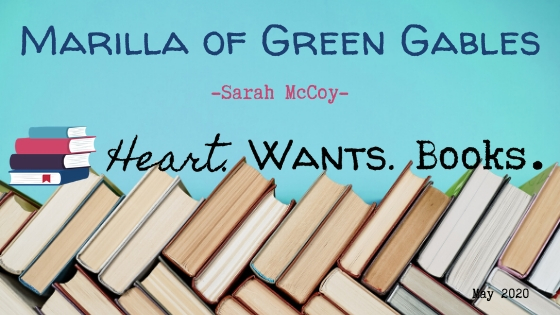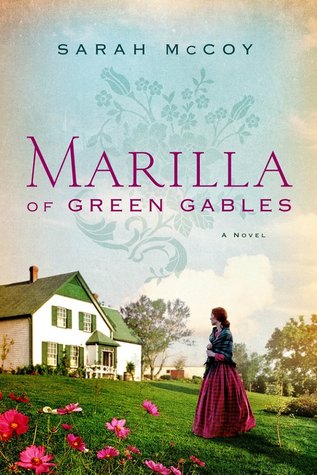Marilla of Green Gables by Sarah McCoy May 7, 2020

The following post includes affiliate links. More details here.
Dear readers, if you’ve been around here for long, you know that I always want more from a title. More epilogue, more backstory, just more time and pages with the characters that I’ve grown to adore throughout their stories. It’s why I adore a series, and one of my favorite parts about romance series, because the spot light may not be on those two characters anymore, but they’re still in the story. I first read Anne of Green Gables as an adult, in the fall of 2016 and knew that Anne and I are kindred spirits. In a fashion true to myself, I didn’t stop with just one book, as I’ve shared, I had an anthology that included all 8 books (they’re not all Anne technically – one is about her family and one about her daughter, Rilla) and I went through them all. And then I read Chronicles of Avonlea, Further Chronicles of Avonlea, The Story Girl, and The Golden Road, and some of Lucy Maud Montgomery’s other titles. Another thing I love about a series, I don’t have to stop to think about what to read next, I just get the next book, or in the case of this set, turn the page again. Anne is probably the reason I ended up getting a Kindle Fire (as my phone didn’t have a blue light setting, way back in the dark ages of 2016), which has greatly contributed to my reading life.

When I heard there was a new book coming about Marilla growing up, I was HERE. FOR. IT. Partially because I adore Anne and wanted more of her world, but also because I wanted to know more about Marilla Cuthbert and the experiences that shaped her into the woman we know and love (especially if you kept going after Anne of Green Gables). Marilla of Green Gables is almost everything I wanted it to be. About ⅔ of the text takes place in 1837-1838, with the last portion in 1860. I’m writing this before rereading Anne (which I have since done) but the feeling, right now, feels right. Marilla is 13 when this book opens, and Matthew is 21, so we get to see the background of Marilla and Matthew’s relationship (some at least), and perhaps best of all, Marilla and Rachel’s relationship! Based on the book, the formative years of Marllia are definitely 1837-1838, so we get a lot of the situations, relationships, and conversations that formed her, but we also get a glimpse of life between teenage Marilla and Marllia in her 50s in 1860 which helps to set the stage for Avonlea and Green Gables as we move back into Anne’s story.
Now that I’ve also re-read Anne, I will say there’s a bit of a disconnect between the Marilla we know growing up and the Marilla we get when Anne’s growing up. Perhaps I’m being an optimist and I just want to like this book, but I think that disconnect is because for 72% of the book, Marilla is a teenager, legit 13 and 14 years old. When Anne opens, she’s 52, so we have less than 100 pages for Marilla to age almost 40 years, and I don’t know about you, but me at 13 is dramatically different than I was at 33, which I imagine will be pretty different than me at 53. There are a couple of specific nuances of Marilla that McCoy explains, and one thing she misses the mark on, or perhaps just didn’t explain the cause of the change. I can overlook that miss because, like Anne would, I want to see the best in this book that is otherwise a beautiful addition.
The most beautiful piece, especially in retrospect, is the voice of the writing. Anne of Green Gables is happy and bubbly just like I would expect Anne to be if she walked in my door later today (don’t I wish someone could, ugh). Marilla of Green Gables has more of a grounded, level voice and style to it that seems to suit Marilla better. Voice and the feeling the prose portrays in its tempo doesn’t seem to be intentional to me usually (although it likely is) but in these two books it stood out as representation of their leading ladies and I am HERE. FOR. IT.
This book is not for the faint of heart, but it’s not tragic, just real. There’s death and heartbreak (and I’ll grudgingly, privately spoil for readers who need to be forewarned), but also there’s hope and contentment. I don’t want readers to go into this thinking Marilla has an easy time of it or that she’s going to find her HEA, because, as we know, her life isn’t easy and she doesn’t marry, neither does Matthew. It’s why they need Anne, because neither has children to help and they both wanted that when they were younger. Why did neither of them marry? Why is the Gables so far off the road? What “bit of romance” has Marllia forgotten (yes, that’s a reference to a conversation between Marilla and Anne in Anne of Green Gables Chapter 37)?
There is one bit that I struggled with, and it’s likely me and historically accurate, however, as modern readers, you may struggle to, so I want to bring it up. When the book opens Marillia is 13 years old and Matthew is 21. There is so much talk of love and marriage for Marllia at 13 and 14. I realize it happened, and I hope that, like Rachel was made to, Marilla would have waited until she was 18 to get married, but still, to become engaged at 14?! Rachel did and it just baffles me! Life was dramatically different over 150 years ago, but I still struggle to imagine that as a 14 year old I would have been able to decide who I would partner with for the rest of my life. I say that, yet in the 1920s, my great-grandmother married at 16, so maybe it wouldn’t be that different, especially with a long engagement. I don’t know, but I struggled, so I wanted to bring it up as a point of contention for this reader.
The bottom line: I have borrowed and read this book, purchased this book, and read it again and I will read it again still. It’s not a comfort read, at least not yet, but it’s a hopeful, familiar book and I’m SO excited to jump into Anne of Green Gables now (as of this writing) and see how the correlation works with the two (as mentioned, pretty well). I strongly encourage readers that have not read Anne’s story to start there. Experience the original first, and then circle back to Marilla’s backstory later on, maybe even go through at least Anne’s eight books first, if you don’t read the short stories of Avonlea and the Story Girl.
~Nikki



